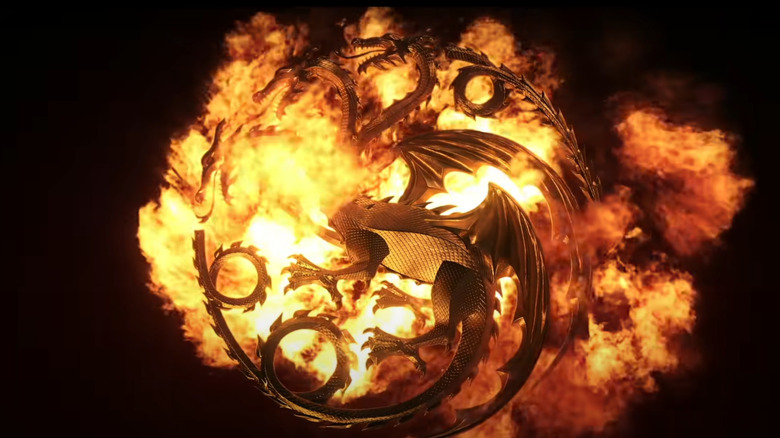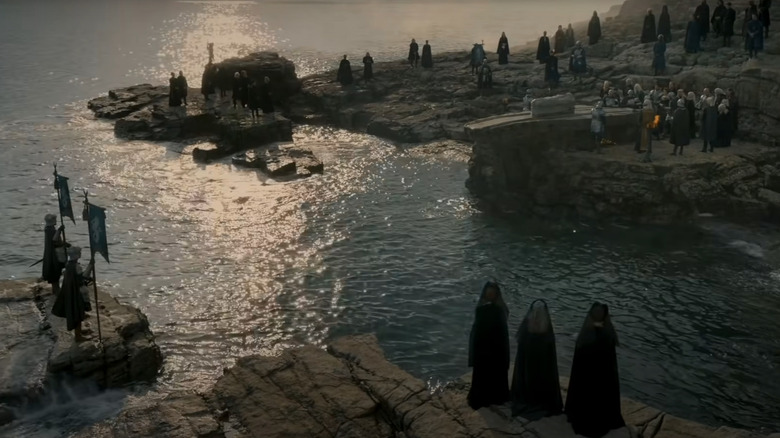House Of The Dragon's Targaryen Sigil Is More Important Than You Think
By the time "Game of Thrones" fever took the world, the history of the famous House of Targaryen had become the stuff of legends within the in-universe lore. With their motto, "Fire and Blood," the Targaryens had taken over a great deal of the world in the past, and they ruled by utilizing their distinct connection to dragons. While other nations and noble houses were predominantly using swords, spears, and arrows to flex their military might, House Targaryen instead soared through the sky on the backs of the fearsome beasts, and the dragons' ability to breathe fire on hapless ranks of infantry and fortified keeps could almost be considered a war crime.
According to Game of Thrones Fandom, the sigil proudly displayed on Targaryen banners consists of a three-headed dragon and a red and black color scheme, which highlights their imposing nature. Now with the "Game of Thrones" prequel "House of the Dragon" on the horizon, it seems as if one of the new showrunners has teased a greater meaning for the Targaryen sigil in the upcoming show.
The new (old) symbol for the Targaryens is different then the one fans are generally familiar with
When we first meet the Targaryens in "Game of Thrones," their once dominating and feared family is reduced to just two members — Daenerys (Emilia Clarke) and Viserys (Harry Lloyd). That number is reduced to just one known Targaryen in the first season after Viserys receives his deadly crown. Daenerys later realizes the power of her blood when she enters a funeral pyre to only come out unscathed and with three dragon hatchlings. These were the first dragons the world had seen in ages, and once they grow up, Daenerys has a powerful means by which to reclaim her family's legacy.
However, "House of the Dragon" is set way before the events of "Game of Thrones," in a time when the Targaryens are still a major power. As such, in an interview with Entertainment Weekly, showrunner Ryan Condal noted that the upcoming sigil is different from the version previously seen on "Game of Thrones," with the symbol in "House of the Dragon" sporting four heads instead of three. Condal said that was intentional, and that every small detail is chosen with care. Condal said, "I will say every choice we made on this show, down to even smaller minutia than that, was made with a reason. I would say stay tuned. But I also say that the sigil that you're seeing in this show you did see in the original show, as well."
A series showrunner has said that the symbol is important
Continuing in his interview with Entertainment Weekly, Ryan Condal added, "The truth of the matter is you think you've seen the Targaryen sigil a lot in the original Game of Thrones, but actually it's not in Game of Thrones that much. You've seen it on books and Funko Pops and things like that. That was how far and high the Targaryen dynasty had fallen, that the sigil did not exist really anymore until Daenerys brought it back about." He continued, "So we chose to go down a road that I think honored where Daenerys left us off versus where people think it all started. But I will say, stay tuned. Hopefully, it will all make sense in due time."
According to HBO, "House of the Dragon" is set 200 years before "Game of Thrones," and will tell the story of the Targaryen nobility, laying the groundwork and foundation for the events to come. Though we see Daenerys eventually become a powerful and ruthless ruler in "Game of Thrones," a lot of dialogue in the series implies that the Targaryens were brutal rulers in their own right, something that eventually leads to their downfall and near extinction. However, in "House of the Dragon," the Targaryens are very much still in power, but this is the world of "Game of Thrones" we are talking about, so it is more than likely that betrayals will shake up the dragon-riding family on more than one occasion. Either way, it will be interesting to see how a group of Targaryens act in the upcoming show, and now fans have something to look out for in the form of their sigil and its implications.


